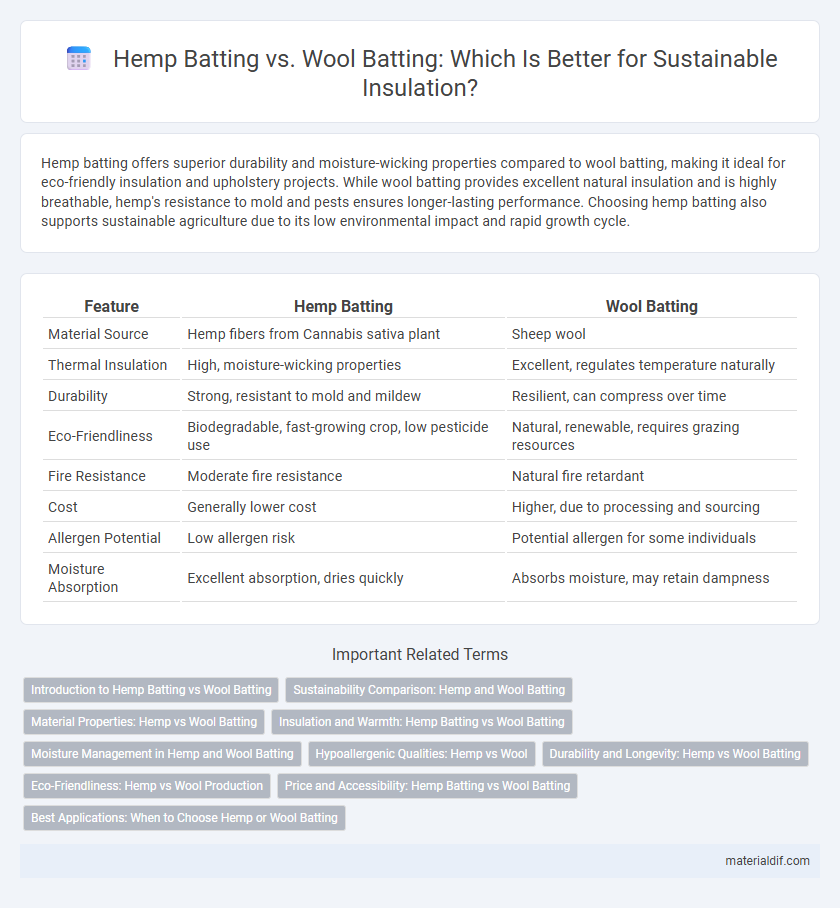Hemp batting offers superior durability and moisture-wicking properties compared to wool batting, making it ideal for eco-friendly insulation and upholstery projects. While wool batting provides excellent natural insulation and is highly breathable, hemp's resistance to mold and pests ensures longer-lasting performance. Choosing hemp batting also supports sustainable agriculture due to its low environmental impact and rapid growth cycle.
Table of Comparison
| Feature | Hemp Batting | Wool Batting |
|---|---|---|
| Material Source | Hemp fibers from Cannabis sativa plant | Sheep wool |
| Thermal Insulation | High, moisture-wicking properties | Excellent, regulates temperature naturally |
| Durability | Strong, resistant to mold and mildew | Resilient, can compress over time |
| Eco-Friendliness | Biodegradable, fast-growing crop, low pesticide use | Natural, renewable, requires grazing resources |
| Fire Resistance | Moderate fire resistance | Natural fire retardant |
| Cost | Generally lower cost | Higher, due to processing and sourcing |
| Allergen Potential | Low allergen risk | Potential allergen for some individuals |
| Moisture Absorption | Excellent absorption, dries quickly | Absorbs moisture, may retain dampness |
Introduction to Hemp Batting vs Wool Batting
Hemp batting offers a sustainable alternative to wool batting, derived from the fibers of the hemp plant known for its durability, moisture-wicking, and hypoallergenic properties. Wool batting, sourced from sheep, provides excellent insulation, natural fire resistance, and breathability but may cause allergies for sensitive individuals. Comparing hemp and wool batting highlights hemp's eco-friendly advantages and wool's traditional warmth and softness in textile and upholstery applications.
Sustainability Comparison: Hemp and Wool Batting
Hemp batting offers superior sustainability compared to wool batting due to its rapid growth cycle, requiring less water and pesticides, and its ability to regenerate soil health through phytoremediation. Wool production involves livestock farming, which contributes significantly to greenhouse gas emissions and requires extensive land and water resources. Hemp's durability and biodegradability further enhance its environmental benefits, making it a more eco-friendly choice for sustainable insulation and textile applications.
Material Properties: Hemp vs Wool Batting
Hemp batting offers superior durability and moisture-wicking properties compared to wool batting, making it highly resistant to mold and mildew in humid environments. Wool batting provides excellent insulation and natural fire resistance, but it tends to retain moisture, which can lead to compression over time. The choice between hemp and wool batting depends on the desired balance of sustainability, breathability, and thermal performance for specific insulation applications.
Insulation and Warmth: Hemp Batting vs Wool Batting
Hemp batting offers superior moisture-wicking properties and breathability, making it an excellent insulator for maintaining warmth without overheating, especially in humid conditions. Wool batting excels in natural insulating capabilities with excellent thermal regulation, providing consistent warmth even when damp due to its lanolin content. Both materials provide effective insulation, but hemp is preferred for eco-friendly, hypoallergenic applications while wool is favored for traditional warmth and resilience.
Moisture Management in Hemp and Wool Batting
Hemp batting excels in moisture management due to its high absorbency and quick-drying properties, which help regulate indoor humidity and reduce the risk of mold growth. Wool batting also offers superior moisture-wicking capabilities, absorbing up to 30% of its weight in moisture without feeling damp, thereby maintaining insulation effectiveness. Compared to wool, hemp provides a more breathable and durable option, making it ideal for environments with variable humidity levels.
Hypoallergenic Qualities: Hemp vs Wool
Hemp batting is highly valued for its hypoallergenic properties, making it an excellent choice for individuals with sensitive skin or allergies, as it resists dust mites and mold growth naturally. Wool batting, while also breathable and moisture-wicking, may trigger allergic reactions in some people due to lanolin and natural oils present in the fibers. Choosing hemp batting enhances indoor air quality and reduces allergens, providing a safer and more comfortable environment for allergy sufferers.
Durability and Longevity: Hemp vs Wool Batting
Hemp batting outperforms wool batting in durability due to its strong, long fibers that resist compression and wear over time, maintaining insulation value and shape. Wool batting, while naturally resilient and moisture-wicking, tends to break down faster with frequent use and exposure to humidity. Choosing hemp batting ensures a longer-lasting, eco-friendly insulation solution that withstands repeated stress and retains effectiveness for years.
Eco-Friendliness: Hemp vs Wool Production
Hemp batting offers superior eco-friendliness compared to wool, as hemp cultivation requires significantly less water and pesticides while enhancing soil health through nitrogen fixation. Wool production involves raising sheep, which contributes to methane emissions and requires extensive land resources, intensifying its environmental footprint. Hemp's rapid growth and low-impact farming make it a sustainable alternative for insulation and textile applications.
Price and Accessibility: Hemp Batting vs Wool Batting
Hemp batting is generally more affordable than wool batting due to lower production costs and increasing industrial hemp cultivation, making it a cost-effective option for insulation and upholstery. Wool batting, while offering superior moisture-wicking and natural fire resistance, tends to be pricier and less readily available, especially outside specialized or artisan markets. Accessibility of hemp batting is improving with expanding hemp farming regulations and growing consumer demand, whereas wool often depends on regional sheep farming and seasonal availability.
Best Applications: When to Choose Hemp or Wool Batting
Hemp batting excels in insulation and moisture-wicking, making it ideal for eco-friendly bedding, furniture padding, and soundproofing in humid environments. Wool batting offers superior thermal regulation and natural fire resistance, perfect for quilts, winter clothing, and upholstery in colder climates. Choose hemp batting for sustainable, durable insulation and wool batting for warmth and breathability in temperature-sensitive applications.
hemp batting vs wool batting Infographic

 materialdif.com
materialdif.com